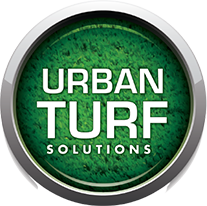Artificial grass installation is very easy and quick which can be done within a couple of days. Below is the instruction on how to do it yourself:
Install a further layer of weed membrane, not only as extra protection against weeds but also as it helps to protect the underside of your artificial grass. Overlap the edges of weed membrane to ensure weeds cannot penetrate between two pieces. Pin the membrane either to the edging or as close to it as possible and trim any excess. It’s very important to ensure the membrane is laid flat as any ripples may be visible through your artificial grass.
NOTE: If you have a dog or pet that will be using your artificial lawn, we recommend that you DO NOT install this additional layer of membrane as it can potentially trap nasty odours from urine.
If done correctly, the joints should not be visible. Firstly, line up both pieces of grass ensuring that the pile direction is facing the same way and that they run parallel to each other. Fold back both pieces of grass by around 300mm to reveal the latex backing. Cut off 1 stitch from each piece of grass, being careful to ensure you cut in a straight line. Then lay each piece flat again and check that the edges of the two pieces of grass meet. There should be a consistent 1–2mm gap. Once both pieces are properly positioned, fold the grass back over again to reveal the latex backing.
Next, roll out the joining tape between the two lengths of grass and nail them down on the ground from both ends. Peel the tape out and carefully turn each piece of grass back into position, making sure the grass fibres do not make contact with the adhesive or get buried. Ensure there is good contact between the grass and adhesive by carefully walking along the join to ensure contact (TIP: place your unopened bags of kiln dried sand along the length of the join to further aid adhesion). Finally, allow the adhesive sufficient time to cure (between 2–24 hours, depending on weather conditions).

© 2024 All Rights Reserved
| Powered by Fresh Digital